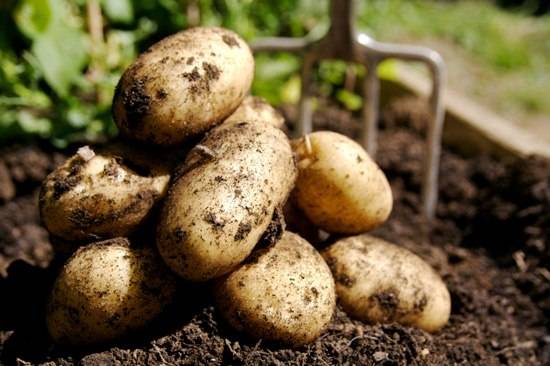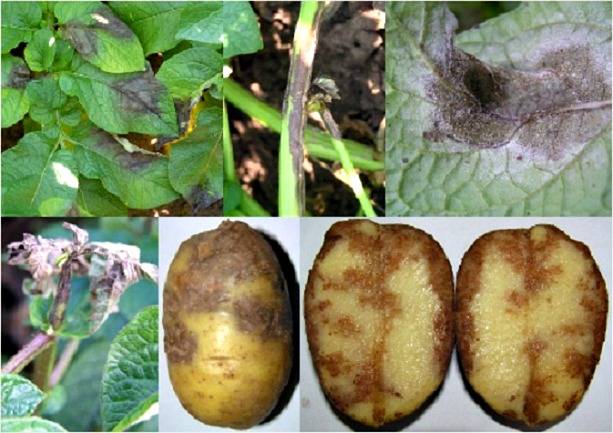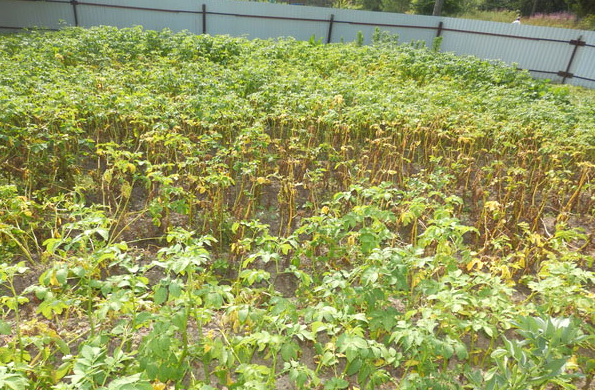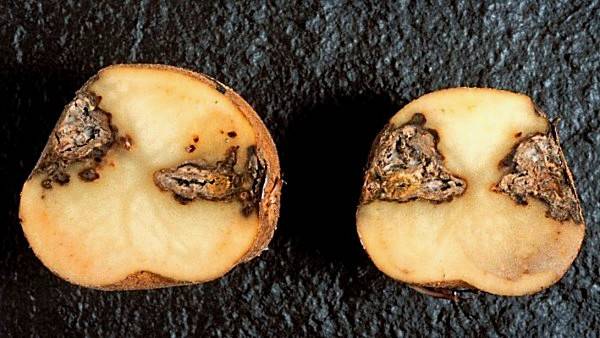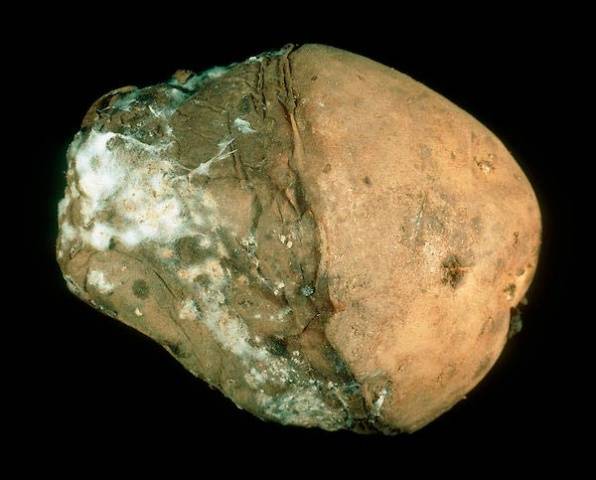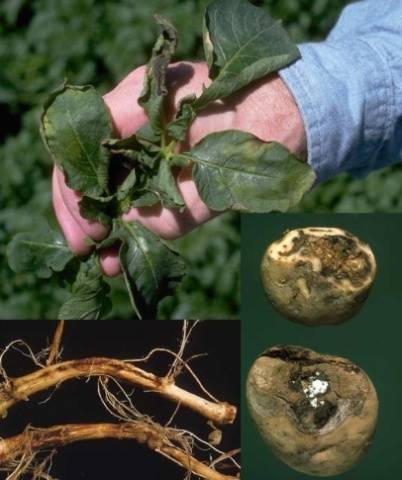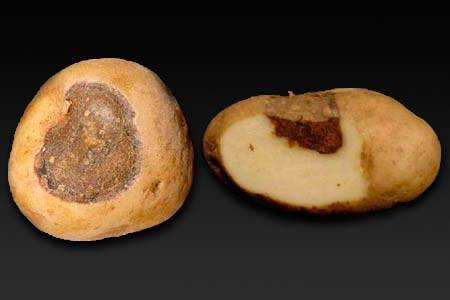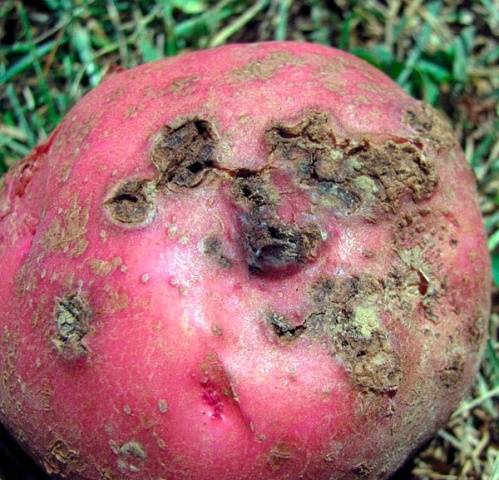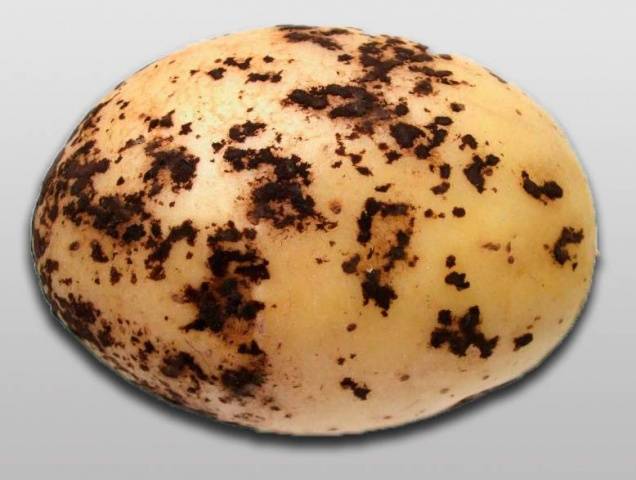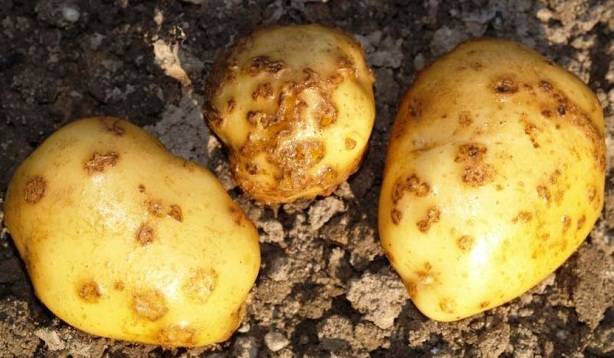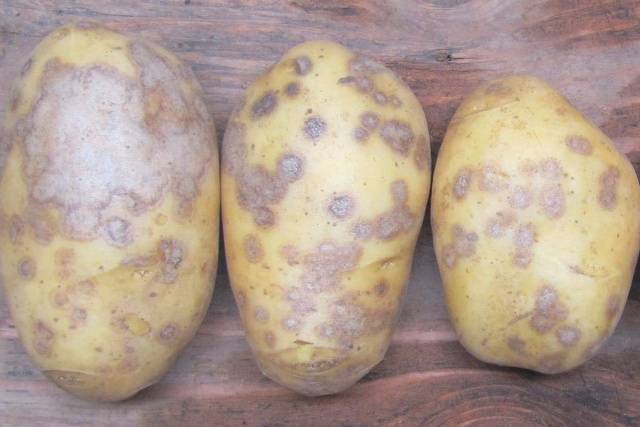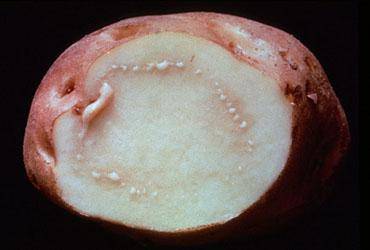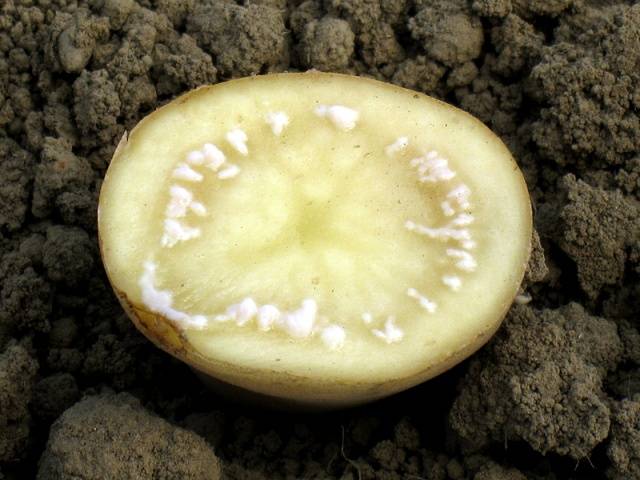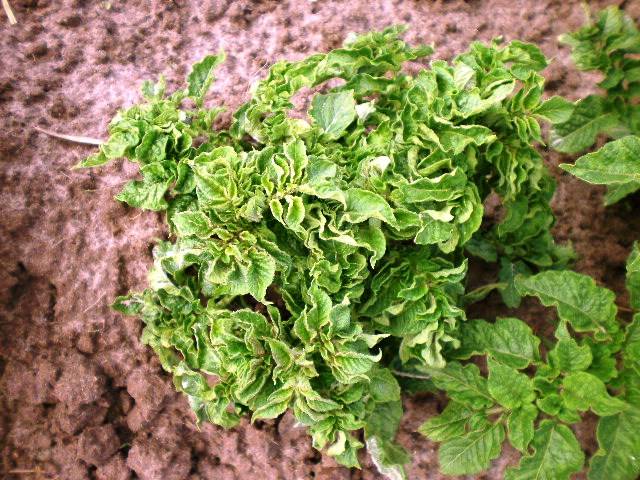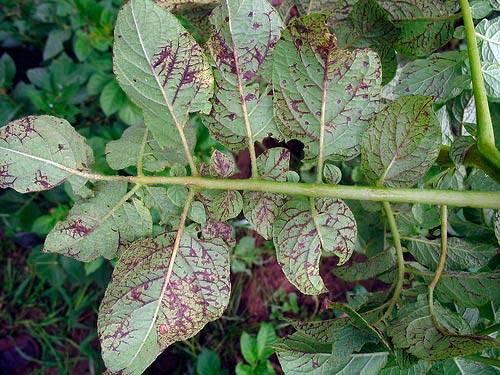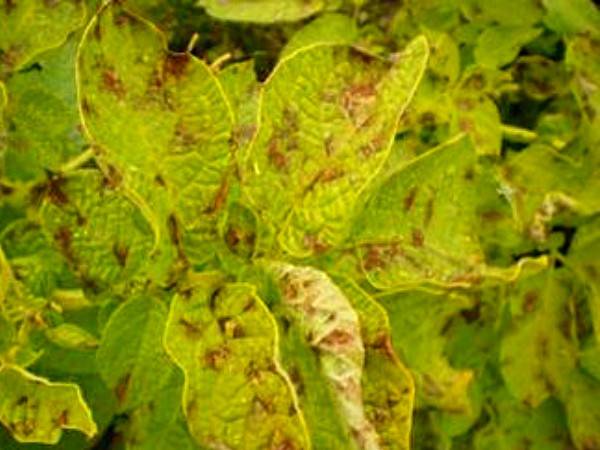Content
Many gardeners traditionally grow large quantities of potatoes in order to stock up on vegetables for the whole winter. But, like many other crops, potatoes are susceptible to some characteristic diseases, which, despite the efforts of the farmer, reduce the yield and quality of the product, slow down the process of its ripening.
When signs appear diseases the gardener needs to take measures to treat the potato to prevent the spread of infection and keep the fruit healthy. A number of preventive measures will allow to protect the planting of vegetables in advance. So, the most common potato diseases and the fight against them, as well as the recommended preventive measures, are described below in the article. This information will surely help the novice and experienced farmer identify the problem and deal with it successfully.
Potato diseases and their treatment
Fungi, bacteria and viruses can cause potato diseases. They penetrate into the body of the plant through the root, leaves, damaged areas of the stem. For each disease there are a number of characteristic signs, in the presence of which the gardener must immediately take measures to treat the plants.
Fungal diseases
Spores of a pathogenic fungus can spread with a stream of air and water droplets. Moving in a dormant state, they are attached to the surface of potato leaves and wait for the onset of favorable conditions for development. As a rule, this is a high level of humidity and low air temperatures. Having struck one plant, the fungal disease quickly spreads throughout the entire planting area. Broad-spectrum fungicides are often used to treat fungal diseases. In addition, in the fight against each individual disease, you can use special drugs and follow some recommendations to eliminate the problem.
Late blight
This well-known fungal disease is characteristic not only of potatoes, but also of all other nightshade crops. Its first sign is the appearance of brown spots on the outside and white bloom on the back of the plant's leaves. If you do not take appropriate measures to treat late blight at an early stage of the development of the disease, then literally in a month all potato plantings can suffer from the fungus: the leaves of the plants will turn brown, dry, brown, dense, deeply penetrating spots will appear on the tubers. With increased air humidity, the affected potato tops rot over time, during a period of drought, it withers and dries up.
The causative agents of late blight can be in the soil or travel through the air. Planting material can also be infected with phytophthora spores. Among the preventive measures to combat the disease, we can recommend:
- do not plant potatoes in the same place from year to year;
- plant planting material only after germinated treatment with antifungal drugs;
- place potato plantings far from other nightshade crops;
- to huddle bushes, forming high mounds at the trunk of plants;
- when potato shoots exceed 20 cm, for preventive purposes, plantings should be treated with copper sulfate, adding 1 g of substance per 1 liter of water.
Potato preventive protection usually shows a high level of effectiveness. However, in some cases, weather conditions and the aggressiveness of the fungus still contribute to the development of the disease. To combat it, it is necessary to process the potato tops with a Bordeaux mixture, preparing a solution of 1% concentration. A single treatment with this agent is not enough to completely destroy the fungus, so the event is repeated every week for a month.
IN fight against late blight you can use other special drugs, you can learn more about which from the video:
Potato cancer
This fungal disease is one of the most dangerous, since eating damaged tubers can provoke the development of certain diseases in humans. Cancer manifests itself only on potato tubers in the form of lumpy growths. They are formed mainly at the eyes of the potato and eventually spread over its entire surface. In rare cases, you can see the symptoms of the disease on the leaves and trunks of the plant.
Spores of the cancerous fungus hide in the soil and are highly viable. If potatoes of one season have signs of cancer, then henceforth only varieties resistant to the disease can be sown on this place, for example, "Belorusskiy", "Stolovy 19", "Falenskiy", "Lvovskiy white" and some others. When growing such resistant varieties in 3-5 years, it will be possible to completely clear the soil from the fungus of this disease.
Often, potato cancer fungi are transferred from one piece of land to another by means of equipment. You can prevent this spread of the disease by disinfecting all instruments with chloride solution. Unfortunately, it is useless to treat the disease itself on the bushes in the process of growing a crop.
Fomoz
This fungal disease, at first glance, may seem harmless. It develops in the second half of the cultivation period and the first signs of phomosis are vague dark spots on the leaves of the plant. Small ball-shaped growths can be observed on the stems.
Digging up potatoes, the farmer will not find signs of the disease on the tubers, however, they will certainly appear during storage. This is the insidiousness of phomosis. After harvest, dark spots with dry rot are formed on the tubers. Their diameter can reach 5 cm. On each potato sometimes there are not one, but several spots at once. If such a potato is cut, then you can see a clear border between the affected and healthy tissue.
It is recommended to fight the disease with preventive methods. For this, seed potatoes are treated with special preparations, for example, "Maxim", before being embedded in the ground. After processing, the planting material is dried and sown.
Verticillary wilting
Sometimes at the end of the flowering period, you can see yellow leaves on the potato tops. If the yellowing begins at the top of the bush and spreads rapidly downward, then we can conclude that the potato is sick with verticillary wilting or, for short, wilt. Additional signs of the disease are symptoms:
- lagging behind the sick plant in growth;
- as the disease develops, the leaves and stems of potatoes become brown and fadedie off;
- in the presence of wet weather, the leaves on the back are covered with a pinkish or gray bloom.
A fungal disease spreads in conditions of moderate temperatures from +16 to +250C. Its development is favored by dry weather and light soil. The peak of development of the disease often occurs at the end of flowering.At the same time, the symptoms of infection with the disease are initially observed only on the leaves of potatoes. As soon as the harvest is placed in the cellar for storage, the vilt fungi will manifest themselves, as a result of which the potatoes will quickly rot and become unusable.
It is useless to treat potatoes from verticillary wilt. Fungi are resistant to various chemicals. The development of the disease can be prevented by removing the diseased bush. Harvesting potatoes must begin with a complete mowing of the tops and burning them. Only after removing the remaining vegetation can the tubers be dug out. Such a measure will reduce the likelihood of additional infection of vegetables. Next year, in the place where the potatoes grew, and signs of vilt were observed, corn, clover or green manure should be sown.
Fusarium wilting
The disease is often referred to as dry rot. It develops in hot weather during intense evaporation of moisture. Excessive watering of plants can be a prerequisite for the development of the disease. Crop infection occurs during different periods of the growing season, but the highest probability of infection is during flowering.
Symptoms of fusarium wilting on potatoes are:
- change in leaf color. The edges of the lower leaves become slightly purple, the top of the bush brightens;
- the leaves of a diseased bush lose their elasticity and wither;
- the stem becomes brown;
- at high air humidity, the stem breaks with a fungal bloom of orange or pink color and rots;
- spots appear on the tubers, covered with a fluffy bloom of white or gray. Over time, vegetables become rotten.
Unfortunately, the disease spreads very quickly from one bush to another. It is possible to prevent spreading only with the timely removal of the affected bush. After being affected by the fungus, the potato tops literally wither and die in 3-4 days. Leaves, stems and tubers from such plants are carriers of the disease, so they must be removed from the site.
Treating seed potatoes before sowing with fungicides will reduce the likelihood of developing the disease. To reduce the likelihood of infection of tubers during the harvesting process, you can pre-mow the tops.
Alternaria
Fungal disease is sometimes also called dry spot of potatoes. It more often affects the culture of late ripening. Under favorable conditions, the disease can destroy a significant amount of the crop, up to 30%.
Alternaria symptoms are brown, large enough spots on the leaves. They can be seen more often after 2-3 weeks from the beginning of flowering. Over time, spots cover the entire leaf plate, as a result of which it dies off. A characteristic symptom of the disease on the tubers is slightly depressed dark spots. The skin on their surface may wrinkle.
To combat Alternaria, fungicides and some other biological and chemical preparations are used. These include "Acrobat MC", "Ditan M-45", "Mankotsev". Seed treatment with fungicides can also be a preventive measure in the fight against an illness.
All of these diseases of fungal origin can be prevented by treating seed potatoes before sowing in the ground with fungicides. The most common drugs among fungicides are Fitosporin and Maxim.Proper care of potato plantings will also prevent the development of fungal diseases: regular and thorough weeding, hilling of plants will not allow harmful microorganisms to get to the surface of the tubers. Regular inspection of the tops and timely destruction of the diseased bush will prevent the spread of infection over all cultivated areas.
Potato scab
A disease like potato scab combines several different diseases of a fungal nature at once, which appear on the skin of the tubers and, less often, on the leaves and stems of the tops. Diseases of this type are not able to completely destroy the crop, but the fungus still significantly impairs the presentation and quality of vegetables. The following types of scab are distinguished:
- Common scab develops on slightly acidic soils at an air temperature of more than +250C and unimpeded access of oxygen. Well-hilled potatoes are rarely affected by this disease. The characteristic feature of the disease is rough dark spots on the skin of the tubers. Sometimes cracks appear at the site of the spots. These potatoes are edible, but not very attractive in appearance. Prevention of the development of common scab is the introduction of manganese and boron into the soil, as well as the cultivation of potato varieties that are resistant to disease and compliance with the rules of crop rotation.
- Black scab Is another type of fungal disease that develops in conditions of high temperature and high humidity. The disease can damage not only potato tubers, but also destroy young shoots obtained by sowing infected material. Signs of black scab, also called rhizoctonia, are ulcerative spots on potato tubers up to 2 cm in diameter, as well as dark brown spots on the leaves of the tops. Under the influence of the disease, they acquire fragility and break down. It will not be possible to store potatoes with signs of black scab for a long time, since the crop will quickly begin to rot. To prevent the development of this fungal disease, seedlings are treated with Mancoceb, Ditan M-45 or their analogs before being embedded in the ground. As a preventive measure to combat the disease, it is recommended to sow scab-resistant potato varieties and follow the rules of crop rotation.
- Powdery scab has a lot of characteristic features that appear on tubers, stems, potato tops. Thus, characteristic growths can be seen on the stems and roots of diseased plants. Their color during the development of the disease changes from white to dark. After the color change, the growths disintegrate. Potato tubers are covered with ulcerative formations of red color, no more than 7 mm in diameter. The source of the disease is a fungus, it can be on the surface of seed potatoes or in the soil. Therefore, it is recommended to treat the planting material with a fungicide before embedding it in the ground. Ulcers on potatoes caused by this fungal disease do not pose a particular threat at the stage of storage of the crop, however, various putrefactive infections, fungi, and bacteria can enter the vegetable cavity through them. It is necessary to store such potatoes in strict observance of certain humidity and temperature conditions.
- Silver scab easy to distinguish from all other types of disease. It appears only on tubers during winter storage. Promotes the development of the fungus temperature above +30C and air humidity over 90%. In such conditions, closer to spring, a gray sheen can be observed on the surface of the stored crop. The weight of such tubers decreases as they significantly lose moisture. Dry, depressed spots appear on the surface of the potatoes. Such anomalies during storage are caused by infection of the potato during cultivation. The causative agent of the disease can lurk in the soil or on the surface of seed potatoes.You can prevent the development of silver scab by treating potatoes with fungicides before storing them. After processing, the tubers must be well dried for 3 days, and then placed in a cellar with certain humidity and temperature characteristics.
You can fight various types of scab with the help of antifungal and some special drugs, you can find out detailed information about which in the video:
The rules and conditions of storage also play an important role in the safety of the crop: conditions with a temperature of + 1- + 3 are optimal.0With and humidity 80-85%. Before laying the harvest for the winter, the cellar should be treated with a solution of copper sulfate (5%) or bleach (3%).
Bacterial diseases
Various bacteria can damage potatoes and cause significant crop damage. Rot, which damages tubers, making them unsuitable for human consumption, is especially dangerous. Bacterial diseases of potatoes photo description and treatment are given below.
Bacterial brown rot
This disease is like a time bomb. It develops very slowly over several years, but at the same time, at the peak of its development, it can significantly damage the crop. Infected seed potatoes are usually the source of the disease. Once in the soil, bacteria develop slowly and in the first year you may not notice any symptoms of the disease at all. In the second year, during the flowering of potatoes, wilting, yellowing and curling of leaves are observed. The leaf plates of the tops sometimes additionally wrinkle.
On the tubers of diseased plants, a thick, growing layer of brown rot can be observed under the seemingly healthy skin. It literally encircles the fruit and makes it inedible. It will not work to store such a crop for a long time. Sometimes rot grows through the surface of the tuber, which is signaled by dark, watery, loose spots on the surface of the vegetable.
Preventive measures to protect potatoes from disease are compliance with the rules of crop rotation, cultivation of resistant varieties. Before sowing a crop, seed potatoes are recommended to be treated with a biological product "Rizoplan". Unfortunately, there are no special means and chemicals to fight the disease in the process of growing potatoes.
Ring rot of potatoes
This bacterial disease is widespread and can kill up to 45% of the crop every year. The disease is characterized by latent symptoms. The presence of the disease can be suspected only by 2-3 withered stalks of potatoes. In this case, internal lesions occur in all vegetative organs of the plant. On the cut of infected leaves, when pressed, you can see a liquid of light yellow or light brown color. Such a putrefactive formation stains the veins of the leaves in a yellowish color.
Despite the name, rot can develop not only according to the ring principle, but also in spots. Spots and rings form under the skin of the tuber and may not be visible at all from the outside. The damaged areas of the tubers are filled with an oily viscous cream-colored liquid. Over time, the inner spots and rings acquire a brown, dark color.
Treat ring rot useless, you can only prevent the disease before the seed potatoes are planted. So, preventive measures are the introduction of a moderate amount of nitrogen and an increased amount of potash fertilizers into the soil. After harvesting from the field, the potato crop must be carefully selected and dried.
Blackleg
This disease is one of the most insidious, as it can destroy almost the entire seasonal crop. More often, the disease parasitizes in places in the immediate vicinity of cabbage. Symptoms of the disease appear on the stems and tubers of potatoes. The stem in the lower part begins to rot, rotten wet spots can be seen on the tubers. Potato rotting occurs during the growing and storage period.An additional symptom is tough leaves twisted into a boat. When you try to pull the plant out of the soil, the tops come off in the lower part of the stem, where rotting was observed. Symptoms of the disease on potato tubers can be seen closer to autumn. The tubers rot, become soft and at the same time give off an unpleasant odor.
The disease can be prevented by treating seed potatoes before planting with Maxim. Tubers and tops of diseased plants must be removed, since they can be a source of disease for the next year.
Bacterial diseases pose the most serious threat to potatoes, since there are no effective drugs for plant treatment, and the damage from infection is significant. That is why it is important to pay special attention to the choice of planting material and methods of its preventive disinfection.
Potato viral diseases
The well-known mosaic belongs to the category of viral diseases. There are three types of this disease, depending on the strain of the virus that provokes it. In addition to the mosaic, the PLRV virus can cause great damage to potatoes. A detailed description of common viral diseases is given below.
Mosaic
A feature of this viral disease is a pronounced symptomatology on the leaves of the plant. Different strains of the mosaic virus are characterized by certain characteristics:
- Wrinkled mosaic does not damage potato tubers, however, its detrimental effect is that diseased bushes end their vegetative process for several weeks, and sometimes months earlier. In this case, the potato tubers ripen smaller. Weight loss can be as high as 30%. The main symptom of the disease is leaf leaves with a characteristic corrugated surface. Their color is slightly lighter than the color of healthy potato leaves. For the prevention of the disease, it is recommended to sow resistant crop varieties.
- The striped mosaic of the potato shows its symptoms on the leaves of the plant. When infected, spots and stripes of excellent color appear on the leaf plates and stalks of potatoes. On the underside of the leaf, you can also observe a clear symptom of the disease: brown or purple streaks on the veins. During the development of the disease, such spots spread to all vegetative organs of the potato. Under the influence of the disease, the yield of the crop is significantly reduced.
- The speckled mosaic is especially pronounced on young potato leaves. A symptom of the disease is light green and yellow spots of various sizes and shapes. On old leaves of tops, the spots that appear are brown in color. Ailing potato bushes lag behind in growth, the process of photosynthesis in the vegetative organs of the plant is disrupted, and chlorosis occurs. As a result of exposure to this virus, potato tubers grow low in weight.
The source of the mosaic virus can be hidden on the surface of seed potatoes or on the body of insect vectors. When signs of disease appear, the infected plant must be removed from the furrow along with the tubers. If this is not done, then soon it will be possible to observe a massive spread of the disease.
Rolling leaves. PLRV virus
This viral disease is transmitted most often by aphids, however, there are cases when the planting material itself is the keeper of the infection. The disease affects the leaves and tubers of potatoes. Its main symptoms are:
- leaves twisted in a boat along the central vein;
- signs of net necrosis on tubers;
- vegetables are practically devoid of starch.
The precondition for the development of the disease is very dry and hot weather. When spread, the virus can affect more than 50% of the crop.
You can prevent the likelihood of the appearance of the disease by soaking seed potatoes before planting in a solution of boric acid 1.5%.
Tuber spindle
This disease is often referred to as Gothic Potato. Its characteristic feature is the changed shape of the potato: the tubers are smaller, their presentation is lost under the influence of the disease.
Gothic symptoms in potatoes can be seen on the tops and tubers. So, when plants are infected, a purple color appears along the edges of the leaf plate and veins. Young leaves on the bush grow narrow, small. Diseased potato tubers have an elongated, bizarre shape. In the context of an infected vegetable, it has no defects and signs of disease.
Viral diseases tend to cause less damage to potato crops than fungal and bacterial diseases. Viruses spread more slowly and rarely infect tubers. The greatest harm of diseases lies in the deterioration of the commercial qualities of tubers: a change in shape, their lightness, a decrease in the amount of starch. If symptoms of viral diseases are found on single bushes, the damaged plants are removed. If the virus has already infected large areas of crops, it is recommended to use the preparations "Campozan", "Efeton", "Krezacin" and some other antiviral substances.
Conclusion
When growing potatoes, you can face many diseases. Their symptoms and methods of treatment are different, which means that the farmer must accurately diagnose the problem in order to correctly eliminate it. The article lists each of the most common picture potato disease, in order to make it easier for the gardener to navigate in all the variety of diseases. More information about potato diseases can be found in the video:
